Page 3109 of 3371
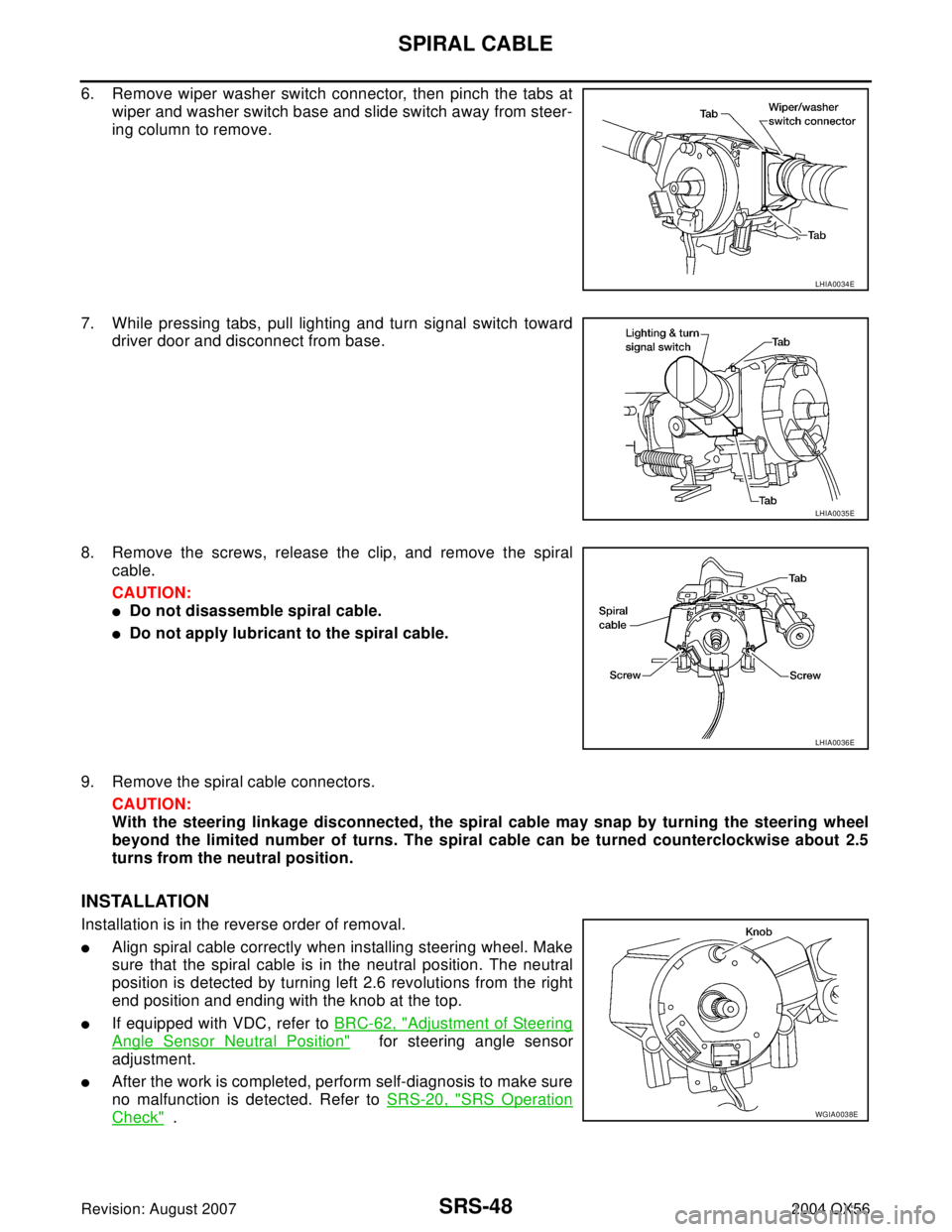
SRS-48
SPIRAL CABLE
Revision: August 20072004 QX56
6. Remove wiper washer switch connector, then pinch the tabs at
wiper and washer switch base and slide switch away from steer-
ing column to remove.
7. While pressing tabs, pull lighting and turn signal switch toward
driver door and disconnect from base.
8. Remove the screws, release the clip, and remove the spiral
cable.
CAUTION:
�Do not disassemble spiral cable.
�Do not apply lubricant to the spiral cable.
9. Remove the spiral cable connectors.
CAUTION:
With the steering linkage disconnected, the spiral cable may snap by turning the steering wheel
beyond the limited number of turns. The spiral cable can be turned counterclockwise about 2.5
turns from the neutral position.
INSTALLATION
Installation is in the reverse order of removal.
�Align spiral cable correctly when installing steering wheel. Make
sure that the spiral cable is in the neutral position. The neutral
position is detected by turning left 2.6 revolutions from the right
end position and ending with the knob at the top.
�If equipped with VDC, refer to BRC-62, "Adjustment of Steering
Angle Sensor Neutral Position" for steering angle sensor
adjustment.
�After the work is completed, perform self-diagnosis to make sure
no malfunction is detected. Refer to SRS-20, "
SRS Operation
Check" .
LHIA0034E
LHIA0035E
LHIA0036E
WGIA0038E
Page 3137 of 3371
TF-12
ALL-MODE 4WD SYSTEM
Revision: August 20072004 QX56
ALL-MODE 4WD TRANSFER BASIC CONTROL
HYDRAULIC CONTROL CIRCUITS
OUTLINE
All-mode 4WD transfer is controlled by the transfer control unit and sensors.
If a malfunction occurs in the all-mode 4WD system, the 4WD warning lamp lights up to indicate the system
malfunction. There are two ways to identify the cause of the malfunction.
1. Performing the self-diagnosis. (The 4WD warning lamp will indicate what kind of malfunction has occurred
by flickering.)
2. Performing diagnosis using CONSULT-II.
LDIA0055E
WDIA0056E
Page 3167 of 3371
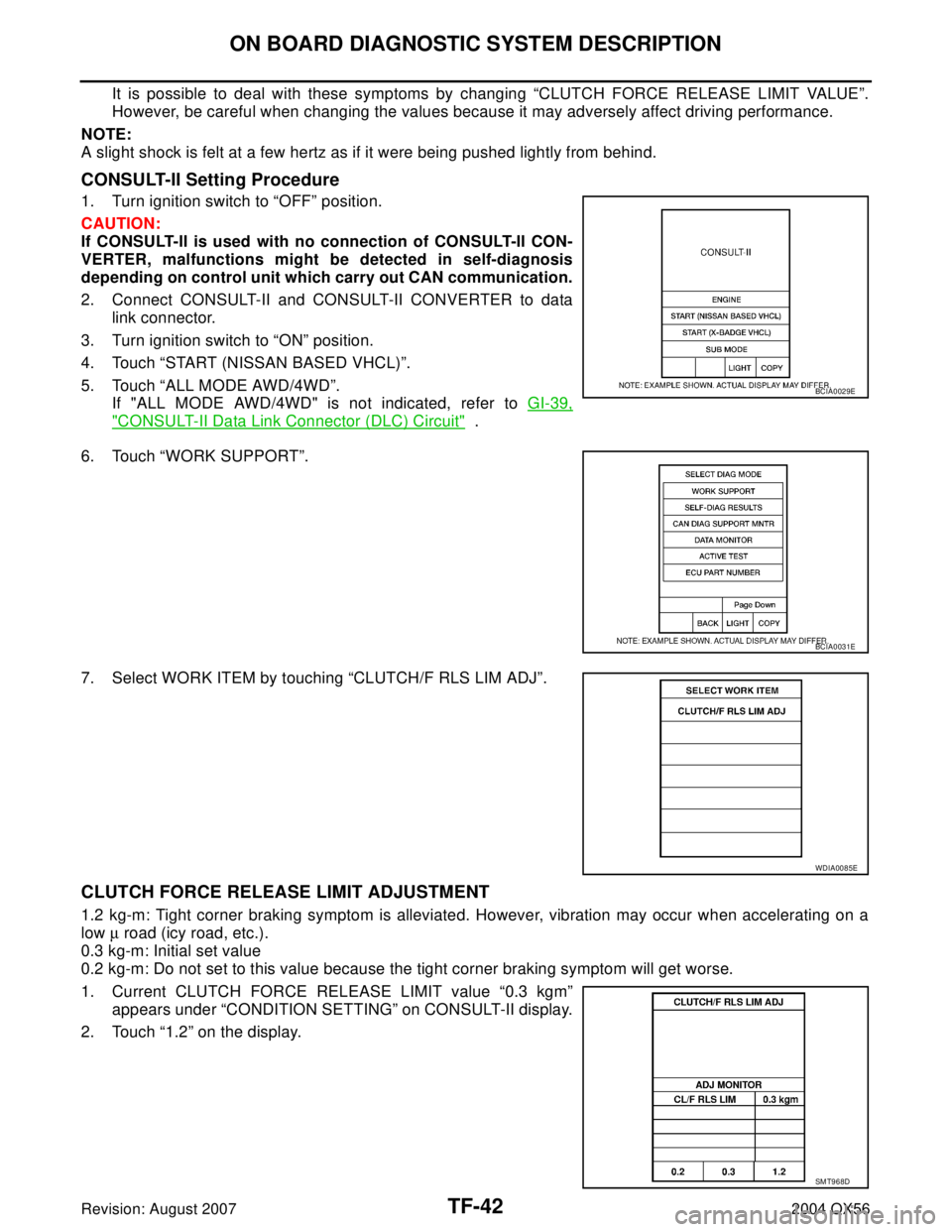
TF-42
ON BOARD DIAGNOSTIC SYSTEM DESCRIPTION
Revision: August 20072004 QX56
It is possible to deal with these symptoms by changing “CLUTCH FORCE RELEASE LIMIT VALUE”.
However, be careful when changing the values because it may adversely affect driving performance.
NOTE:
A slight shock is felt at a few hertz as if it were being pushed lightly from behind.
CONSULT-II Setting Procedure
1. Turn ignition switch to “OFF” position.
CAUTION:
If CONSULT-II is used with no connection of CONSULT-II CON-
VERTER, malfunctions might be detected in self-diagnosis
depending on control unit which carry out CAN communication.
2. Connect CONSULT-II and CONSULT-II CONVERTER to data
link connector.
3. Turn ignition switch to “ON” position.
4. Touch “START (NISSAN BASED VHCL)”.
5. Touch “ALL MODE AWD/4WD”.
If "ALL MODE AWD/4WD" is not indicated, refer to GI-39,
"CONSULT-II Data Link Connector (DLC) Circuit" .
6. Touch “WORK SUPPORT”.
7. Select WORK ITEM by touching “CLUTCH/F RLS LIM ADJ”.
CLUTCH FORCE RELEASE LIMIT ADJUSTMENT
1.2 kg-m: Tight corner braking symptom is alleviated. However, vibration may occur when accelerating on a
low µ road (icy road, etc.).
0.3 kg-m: Initial set value
0.2 kg-m: Do not set to this value because the tight corner braking symptom will get worse.
1. Current CLUTCH FORCE RELEASE LIMIT value “0.3 kgm”
appears under “CONDITION SETTING” on CONSULT-II display.
2. Touch “1.2” on the display.
BCIA0029E
BCIA0031E
WDIA0085E
SMT968D
Page 3169 of 3371

TF-44
TROUBLE DIAGNOSIS — INTRODUCTION
Revision: August 20072004 QX56
TROUBLE DIAGNOSIS — INTRODUCTIONPFP:00000
IntroductionEDS0017W
DESCRIPTION
When a malfunction (indicated by the 4WD warning lamp illumination) occurs, collect information first from the
customer about how the malfunction occurs. Then, proceed with the diagnosis presuming it is the cause. Also
inspect the electrical system, paying close attention to other possibilities such as fluid level and leaks.
All-mode 4WD transfer is controlled by transfer control unit and sensors.
If a malfunction occurs in the all-mode 4WD system, the 4WD warning lamp lights up to inform of the system
malfunction. There are two ways to identify the cause of the malfunction.
1. Performing the self-diagnosis. (The 4WD warning lamp will indicate what kind of malfunction has occurred
by flickering.)
2. Performing diagnosis using CONSULT-II.
DIAGNOSTIC WORKSHEET
Information from Customer
KEY POINTS
�WHAT ..... Vehicle model
�WHEN..... Date, Frequencies
�WHERE..... Road conditions
�HOW..... Operating conditions, Symptoms
Diagnostic Worksheet
Information sheet from customer
Customer name MR/MS Model & Year VIN
Transfer model
AT X 1 4 BEngine Mileage
Incident Date Manuf. Date In Service Date
Frequency❏ Continuous ❏ Intermittent ( times a day)
Symptoms❏ 4WD shift indicator lamp does not turn on.
❏ 4WD warning lamp does not turn on.
❏ 4WD shift indicator lamp does not turn off.
❏ ATP warning lamp does not turn on.
❏ 4LO indicator lamp does not turn on.
❏ 4WD shift indicator lamp does not indicate “4H”.
❏ 4WD shift indicator lamp repeats flicking.
❏ Tight corner braking symptom occurs.
❏ 4WD system does not operate.
❏ Others.
4WD warning lamp❏ Continuously lit❏ Not lit
1.❏ Listen to customer complaints.TF-47
2.❏ Check transfer fluid.TF-47
❏ Leakage
❏ Fluid condition
❏ Fluid level
3.❏ Road testingTF-47
❏ 1. Check before engine is started.
❏ 2. Check at idle.
❏ 3. Cruise test
4.❏ Perform self-diagnosis NG items (with CONSULT-II and without CONSULT-II).TF-31
, TF-28
Page 3180 of 3371
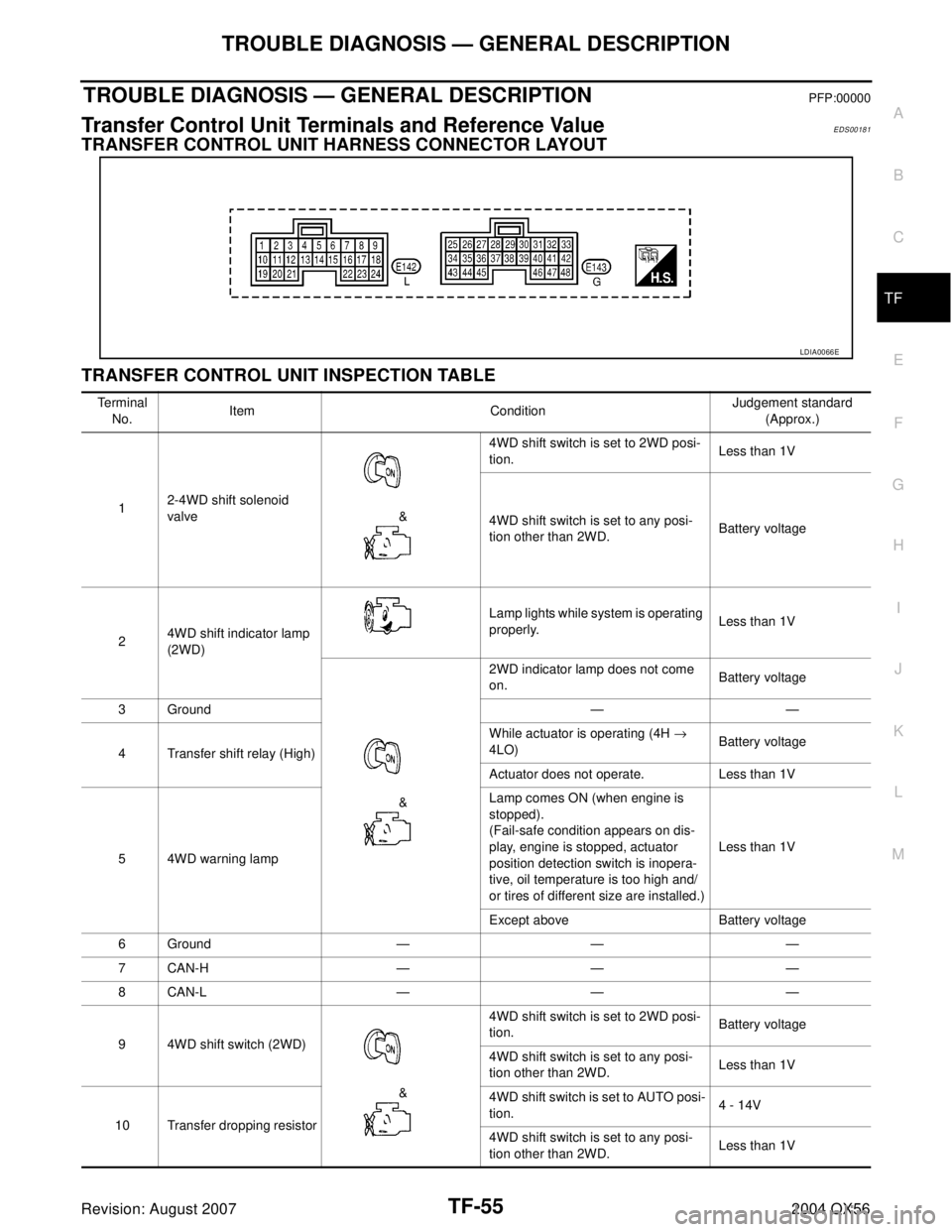
TROUBLE DIAGNOSIS — GENERAL DESCRIPTION
TF-55
C
E
F
G
H
I
J
K
L
MA
B
TF
Revision: August 20072004 QX56
TROUBLE DIAGNOSIS — GENERAL DESCRIPTIONPFP:00000
Transfer Control Unit Terminals and Reference ValueEDS00181
TRANSFER CONTROL UNIT HARNESS CONNECTOR LAYOUT
TRANSFER CONTROL UNIT INSPECTION TABLE
LDIA0066E
Te r m i n a l
No.Item ConditionJudgement standard
(Approx.)
12-4WD shift solenoid
valve &4WD shift switch is set to 2WD posi-
tion.Less than 1V
4WD shift switch is set to any posi-
tion other than 2WD.Battery voltage
24WD shift indicator lamp
(2WD)Lamp lights while system is operating
properly.Less than 1V
&2WD indicator lamp does not come
on.Battery voltage
3Ground — —
4 Transfer shift relay (High)While actuator is operating (4H →
4LO)Battery voltage
Actuator does not operate. Less than 1V
5 4WD warning lampLamp comes ON (when engine is
stopped).
(Fail-safe condition appears on dis-
play, engine is stopped, actuator
position detection switch is inopera-
tive, oil temperature is too high and/
or tires of different size are installed.)Less than 1V
Except above Battery voltage
6Ground — — —
7CAN-H — — —
8CAN-L — — —
9 4WD shift switch (2WD)
&4WD shift switch is set to 2WD posi-
tion.Battery voltage
4WD shift switch is set to any posi-
tion other than 2WD.Less than 1V
10 Transfer dropping resistor4WD shift switch is set to AUTO posi-
tion.4 - 14V
4WD shift switch is set to any posi-
tion other than 2WD.Less than 1V
Page 3275 of 3371
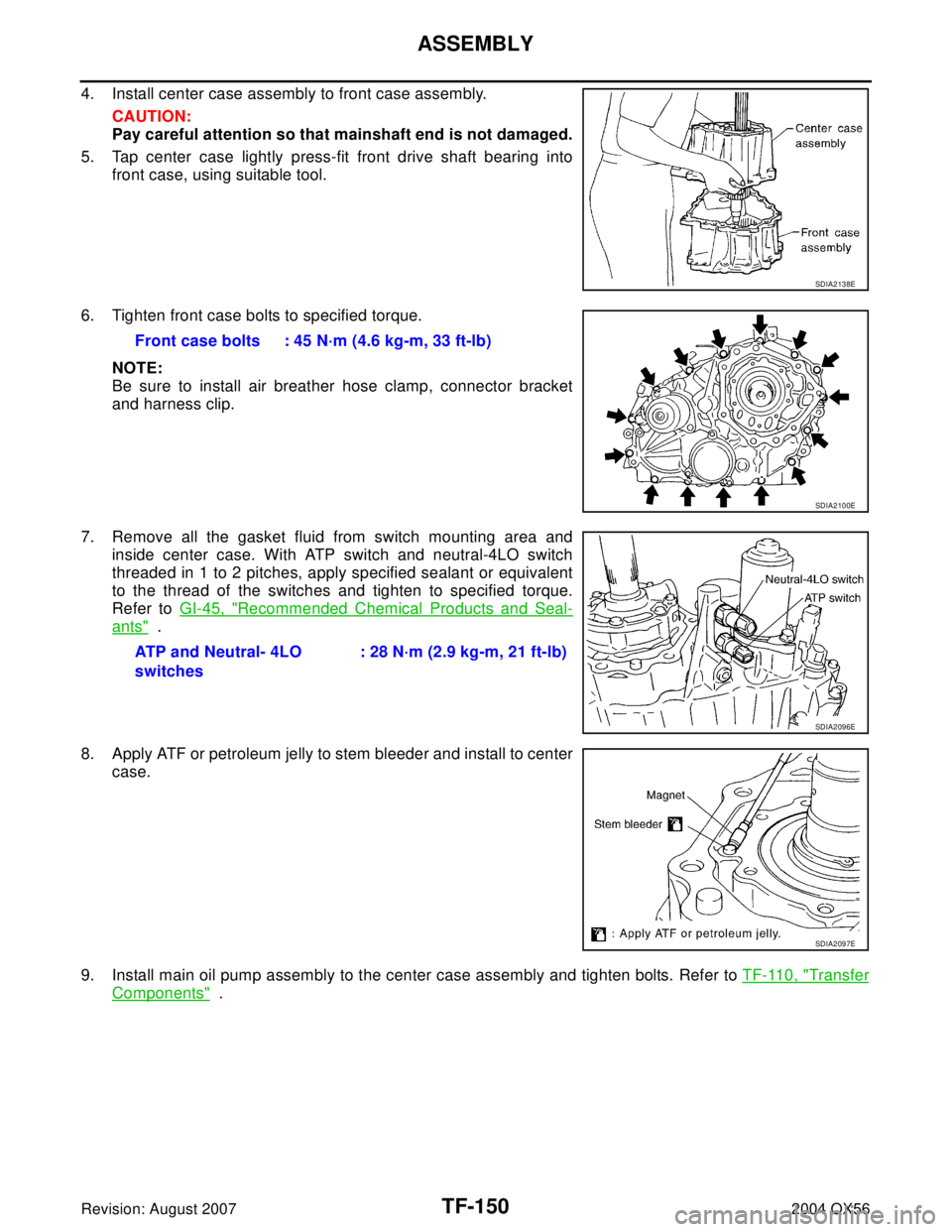
TF-150
ASSEMBLY
Revision: August 20072004 QX56
4. Install center case assembly to front case assembly.
CAUTION:
Pay careful attention so that mainshaft end is not damaged.
5. Tap center case lightly press-fit front drive shaft bearing into
front case, using suitable tool.
6. Tighten front case bolts to specified torque.
NOTE:
Be sure to install air breather hose clamp, connector bracket
and harness clip.
7. Remove all the gasket fluid from switch mounting area and
inside center case. With ATP switch and neutral-4LO switch
threaded in 1 to 2 pitches, apply specified sealant or equivalent
to the thread of the switches and tighten to specified torque.
Refer to GI-45, "
Recommended Chemical Products and Seal-
ants" .
8. Apply ATF or petroleum jelly to stem bleeder and install to center
case.
9. Install main oil pump assembly to the center case assembly and tighten bolts. Refer to TF-110, "
Transfer
Components" .
SDIA2138E
Front case bolts : 45 N·m (4.6 kg-m, 33 ft-lb)
SDIA2100E
ATP and Neutral- 4LO
switches: 28 N·m (2.9 kg-m, 21 ft-lb)
SDIA2096E
SDIA2097E
Page 3325 of 3371
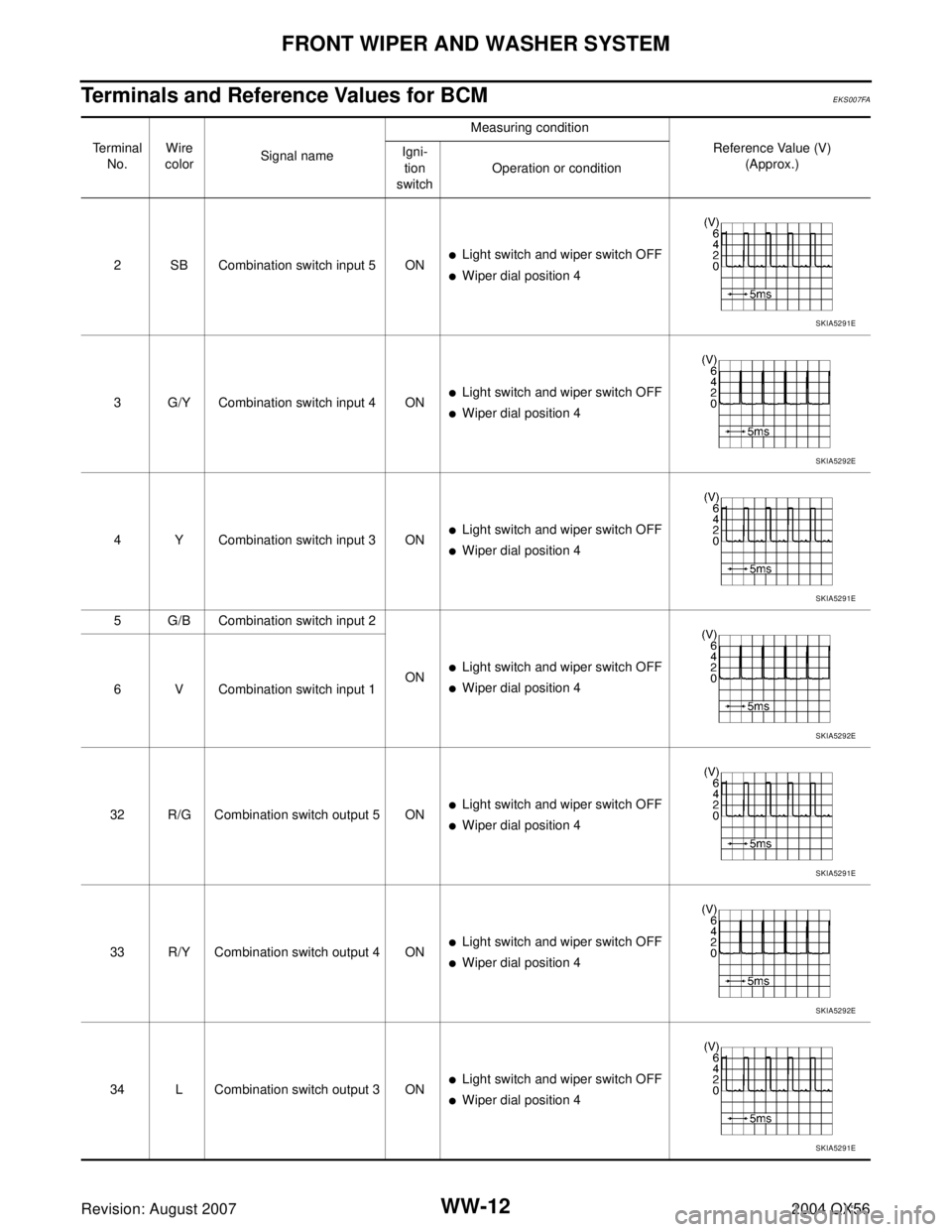
WW-12
FRONT WIPER AND WASHER SYSTEM
Revision: August 20072004 QX56
Terminals and Reference Values for BCMEKS007FA
Te r m i n a l
No.Wire
colorSignal nameMeasuring condition
Reference Value (V)
(Approx.) Igni-
tion
switchOperation or condition
2 SB Combination switch input 5 ON
�Light switch and wiper switch OFF
�Wiper dial position 4
3 G/Y Combination switch input 4 ON
�Light switch and wiper switch OFF
�Wiper dial position 4
4 Y Combination switch input 3 ON
�Light switch and wiper switch OFF
�Wiper dial position 4
5 G/B Combination switch input 2
ON
�Light switch and wiper switch OFF
�Wiper dial position 4
6 V Combination switch input 1
32 R/G Combination switch output 5 ON
�Light switch and wiper switch OFF
�Wiper dial position 4
33 R/Y Combination switch output 4 ON
�Light switch and wiper switch OFF
�Wiper dial position 4
34 L Combination switch output 3 ON
�Light switch and wiper switch OFF
�Wiper dial position 4
SKIA5291E
SKIA5292E
SKIA5291E
SKIA5292E
SKIA5291E
SKIA5292E
SKIA5291E
Page 3326 of 3371
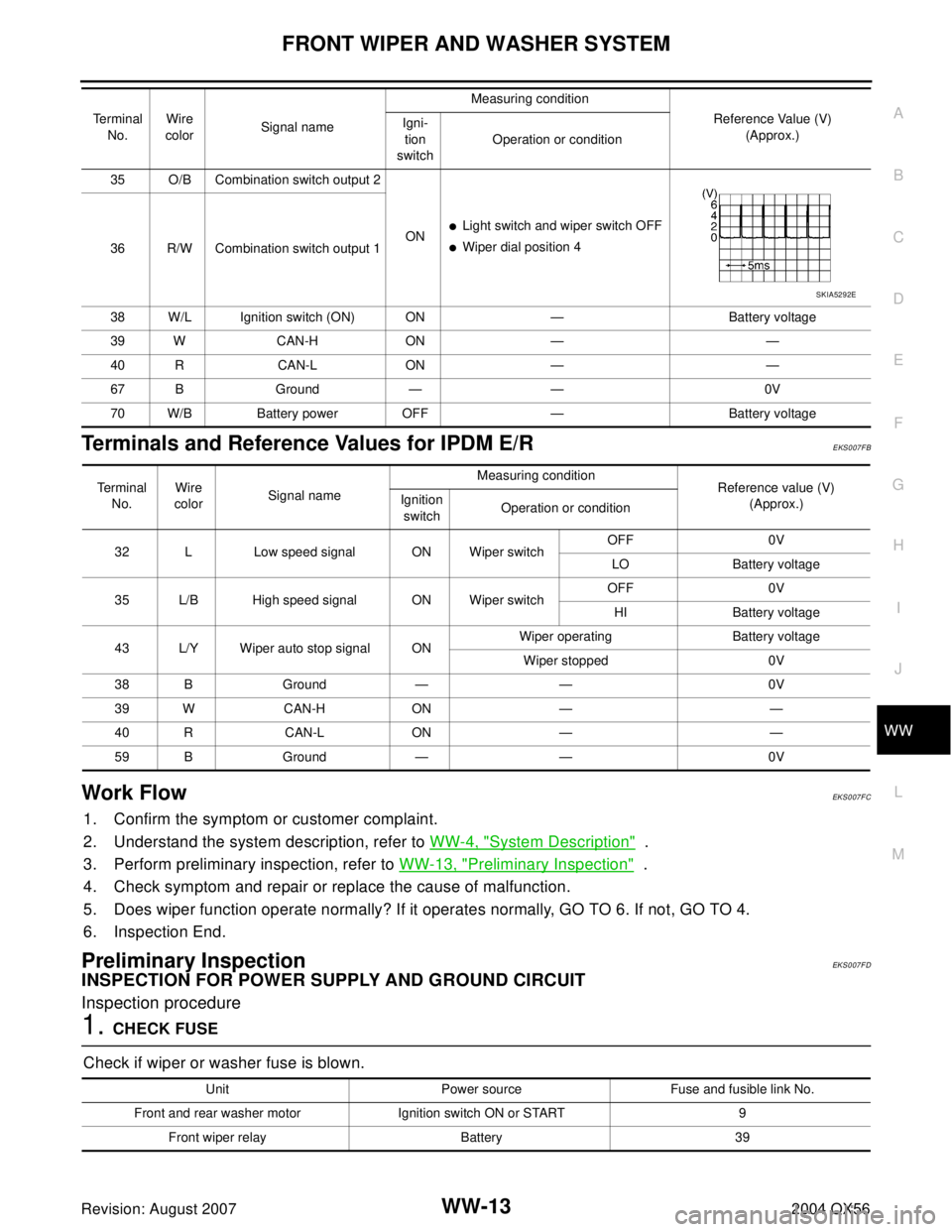
FRONT WIPER AND WASHER SYSTEM
WW-13
C
D
E
F
G
H
I
J
L
MA
B
WW
Revision: August 20072004 QX56
Terminals and Reference Values for IPDM E/R EKS007FB
Work FlowEKS007FC
1. Confirm the symptom or customer complaint.
2. Understand the system description, refer to WW-4, "
System Description" .
3. Perform preliminary inspection, refer to WW-13, "
Preliminary Inspection" .
4. Check symptom and repair or replace the cause of malfunction.
5. Does wiper function operate normally? If it operates normally, GO TO 6. If not, GO TO 4.
6. Inspection End.
Preliminary InspectionEKS007FD
INSPECTION FOR POWER SUPPLY AND GROUND CIRCUIT
Inspection procedure
1. CHECK FUSE
Check if wiper or washer fuse is blown.
35 O/B Combination switch output 2
ON
�Light switch and wiper switch OFF
�Wiper dial position 4
36 R/W Combination switch output 1
38 W/L Ignition switch (ON) ON — Battery voltage
39 W CAN-H ON — —
40 R CAN-L ON — —
67 B Ground — — 0V
70 W/B Battery power OFF — Battery voltage Te r m i n a l
No.Wire
colorSignal nameMeasuring condition
Reference Value (V)
(Approx.) Igni-
tion
switchOperation or condition
SKIA5292E
Te r m i n a l
No.Wire
colorSignal nameMeasuring condition
Reference value (V)
(Approx.) Ignition
switchOperation or condition
32 L Low speed signal ON Wiper switchOFF 0V
LO Battery voltage
35 L/B High speed signal ON Wiper switchOFF 0V
HI Battery voltage
43 L/Y Wiper auto stop signal ONWiper operating Battery voltage
Wiper stopped 0V
38 B Ground — — 0V
39 W CAN-H ON — —
40 R CAN-L ON — —
59 B Ground — — 0V
Unit Power source Fuse and fusible link No.
Front and rear washer motor Ignition switch ON or START 9
Front wiper relay Battery 39